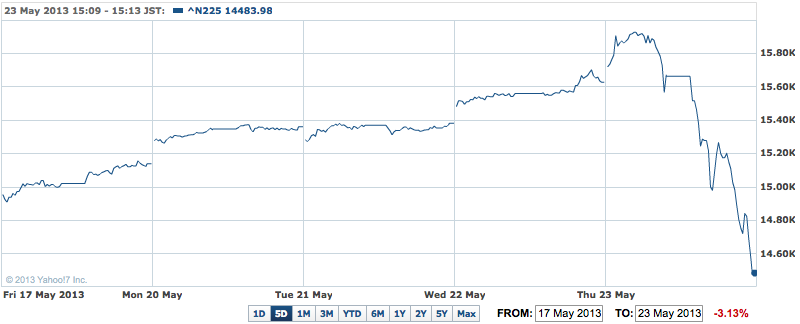A weak manufacturing report from China, worries about the future of the US Fed’s easing program, job losses at Ford and other companies and a general unease with the economy combined to knock more than $A30 billion off the value of local shares yesterday and rattled European markets overnight as well.
But the sell-off came to a halt in the US where shares fell, then steadied to close slightly lower after the release of some encouraging economic news. That will calm nerves in the local market today.
Here, big miners and the banks drove much of the fall, while Telstra lost 3.7%.
The Aussie dollar dipped under 96 USc overnight, but rebounded to close around 97.40 this morning, while oil eased and gold was $US24 higher at $US1391 an ounce in New York.
Not helping was a big sell-off in Japan, with that market seeing a massive 7.3% fall as small investors took profits and bolted for the sidelines after the huge gains since late 2012.
In early trading yesterday Tokyo was up 2%, but the weak early report on Chinese manufacturing knocked it sharply lower as well. The market swung through a huger 10% trading range yesterday.
Nikkei weekly – Japan’s big sell off

It was a similar message across the rest of Asia and into Europe and the US where early futures trading showed big losses (on top of the late fall Wednesday on Wall Street). But those disappeared as trading continued into this morning, our time.
Back home and our market lost $A30 billion as the ASX 200 index slumped 103 points, or 2%, to 5062.4 and the All Ords lost 101.3 points, or 2% to 5040.8.
The news from China set off concerns about iron ore prices and sales, and the prices of the big miners fell.
The banks eased from their high levels because the ANZ, Westpac and the NAB have all declared their dividends, so there’s no need for investors ‘dividend washing’ to be holding them.
As well they fell because of concerns about an early end to the Fed’s latest easing might see US interest rates rise.
Among the losers were: BHP: -1.1%, Rio: -2.1%, ANZ: -4%, CBA: -2.8%, NAB: -3.1%, Westpac: -4.1%, Woolies: -1.5%, Wesfarmers: -2.1%, Telstra: -3.7%.
Of course there were some stocks that rose – QBE was up 6.4%, Worleyparsons more than 4%, Computershare 4.7% and Pacific Brands 4.9%. All rose because of the weakness in the Aussie dollar.
The dollar lost nearly 2 USc from late Tuesday to end around 96 USc in Sydney last night and under that level in offshore trading. That means the currency has now lost more than 6% from the start of May. But it rebounded after the US market turned around on confidence about the economy.
The catalyst for the market nerves was the early report from China’s manufacturing sector. According to the so-called flash report from HSBC, the purchasing managers index (PMI), was shown to be worse than expected at 49.6 rather than forecasts of 50.4 which was the final reading for April.
In other words, activity in the sector contracted slightly – a big turnaround from the expansion for the previous few months. In fact it was the worst reading for seven months and suggests the Chinese economy is slowing and in need of some stimulus.
The news adds to concerns that the entire Asian region is slowing – except for Japan where the economy is rebounding thanks to the weaker trend and rising government and central bank stimulus.
The economies of Thailand, Malaysia, Singapore and Indonesia all showed slowing growth in the March quarter from the December quarter.
South Korea rose but that was after a sharp slowing in the December quarter. Growth in Taiwan has halved and Singapore has seen a surprise rise in the March quarter after an early estimate suggested a contraction, but the rise was well down on the level in the December quarter.
Economists say the region and especially China, Taiwan and Korea are being hurt by slow growth in the US, Europe’s recession, and the uncertainty caused by the sharp fall in the value of the yen since late last year which seems to be damaging export growth from the rest of the region.
The HSBC PMI showed new orders dropped to 49.5, the lowest reading since last September. "The cooling manufacturing activities in May reflected slower domestic demand and ongoing external headwinds," said Qu Hongbin, chief China economist at HSBC.
The survey also showed new export orders hovered below the 50-point level in May, though the rate of decline slowed from April. "A sequential slowdown is likely in the middle of the second quarter, casting downside risks to China’s fragile growth recovery," Qu added in the commentary accompanying the report.













